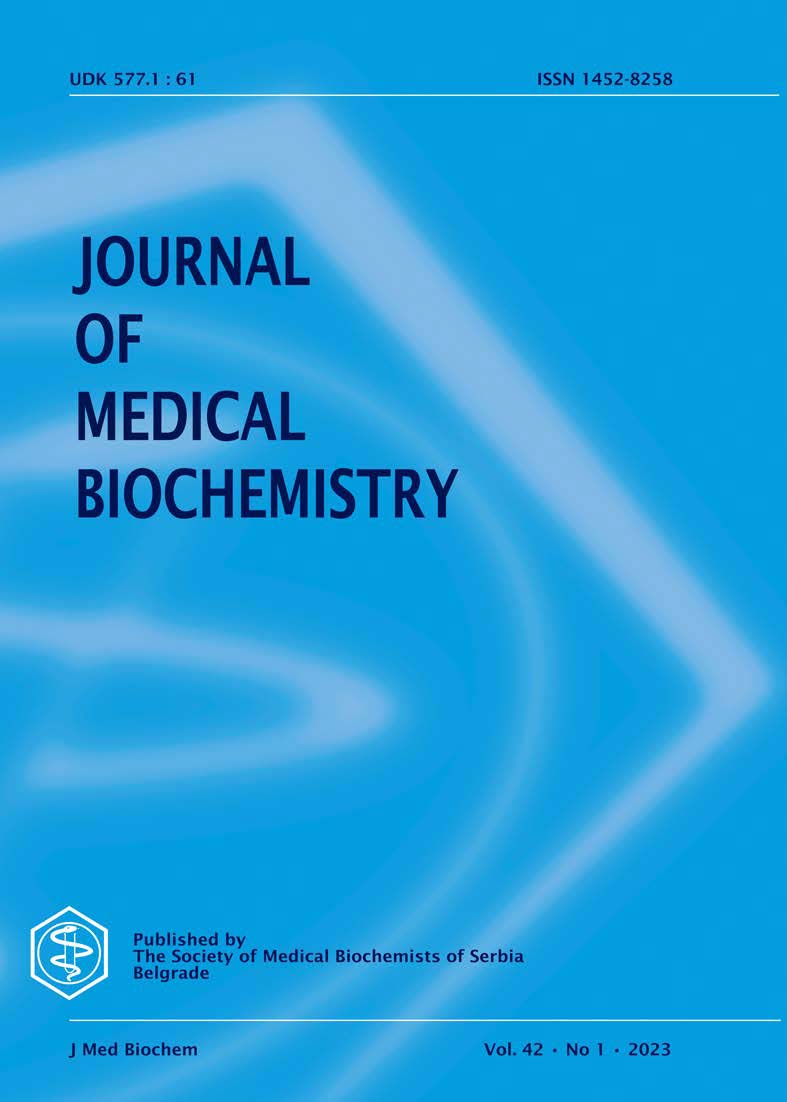Tačnost izračunavanja osmolarnosti seruma kod male dece
Sažetak
Background. Serum osmolality can be measured (Omeas) or calculated (Ocal). Many formulas for Ocal have been already published, but data regarding the most accurate equation in small babies is not available. Thus, we aim to compare Omeas and Ocal obtained by different formulas in newborns and small children.
Methods. The study included 280 serum samples taken from children, from the first day of life to 2 years (mean age 8.2 ± 7.6 months) treated in the University Children’s Hospital in Krakow. The serum osmolality was measured by osmometer and calculated by 8 common formulas.
Results. The mean value of Omeas (285.8±5.1 mOsm/kgH2O) was significantly different as compared to the mean values of Ocal (p<0.01) for all formulas, except Ocal obtained by the formula: 1.86*(Na+K)+1.15*Glu+Urea+14. According to Bland-Altman analysis, this formula showed the best performance for estimating osmolality. In children under 3 months of life Passing-Bablok regression indicated both systematic and proportional error for results obtained by each formula compared to the measured values.
Conclusions. To calculate osmolarity in children aged between 3 months and 2 years old the following equations: 1.86*(Na+K)+1.15*Glu+Urea+14 might be used, whereas serum osmolality in children up to 3 month of life should be measured.
Reference
2. Jain A. Body fluid composition. Pediatr Rev. (2015) 36: 141–142.
3. Zieg J. Pathophysiology of hyponatremia in children. Front Pediatr. (2017) 5: 1-8.
4. Fazekas AS, Funk GC, Klobassa DS, Ruther H, Ziegler I, Zander R, Semmelrock HJ. Evaluation of 36 formulas for calculating plasma osmolality. Intensive Care Med. (2013): 39: 302–308.
5. Turhan G, Kayalp D, Senes M, Yucel D. Effects of lipemia on osmolality in native lipemic material and intravenous lipid emulsion added sera. Clin Chem Lab Med. (2015) 53: 59–61.
6. Westgard QC (2021) www.westgard.com/biodatabase1.htm
7. Erstad BL. Osmolality and osmolarity: Narrowing the terminology gap. Pharmacotherapy. (2003) 23: 1085–1086.
8. Hoffman RS, Smilkstein MJ, Howland MA, Goldfrank LR. Osmol gaps revisited: normal values and limitations. J Toxicol Clin Toxicol. (1993) 31: 81–93.
9. Faria DK, Mendes ME, Sumita NM. The measurement of serum osmolality and its application to clinical practice and laboratory: Literature review. J Bras Patol e Med Lab. (2017) 53: 38–45.
10. Martín-Calderón JL, Bustos F, Tuesta-Reina L, Varoan JM, Caballero L, Solano F. Choice of the best equation for plasma osmolality calculation: Comparison of fourteen formulae. Clin Biochem. (2015) 48: 529–533.
11. Heavens KR, Kenefick RW, Caruso EM, Spitz MG., Cheuvront SN. Validation
of equations used to predict plasma osmolality in a healthy adult cohort. Am J Clin
Nutr. (2014) 100: 1252–1256.
12. Munk T, Bech CB, Klausen TW, Ronholt F, Suetta C, Knudsen Aw. Accuracy of the calculated serum osmolarity to screen for hyperosmolar dehydration in older hospitalised medical patients. Clin Nutr ESPEN (2021) 43: 415–419.
13. Vareesangthip K, Davenport A. Comparison of measuring serum osmolality and equations estimating osmolality in peritoneal dialysis patients. Perit Dial Int (2020) 40: 509–512.
14. Worthley LI, Guerin M, Pain RW. For calculating osmolality, the simplest formula is the best. Anaesth Intensive Care. (1987) 15: 199–202.
15. Choy KW, Wijeratne N. Lu ZX, Doery JC. Harmonisation of Osmolal Gap. Clin Biochem Rev (2016) 37: 113-119.
16. Kar E, Kocatürk E, Küskü Kiraz Z, Demiryürek B, Alataş IÖ. Comparison of
measured and calculated osmolality levels. Clin Exp Nephrol. (2020) 24: 444–449.
17. Uppal N, Uppal V. Evaluation of the Diagnostic Accuracy of the Most Commonly
used Equations for Calculation of Osmolarity in Paediatric Population.
J Clin Diagnostic Res. (2019) 13: 15–17.
18. Westgard JO, Persons N, Westgard S. Basic Method Validation. 4th edn. (Revised & Expanded, 2020).
19. Ebonwu EO, Nagel SE, Repsold L, Pillay TS. Critical evaluation of equations for serum osmolality: Proposals for effective clinical utility. Clin Chim Acta. (2020) 510: 79–87 .
20. Rasouli M, Kalantari KR. Comparison of methods for calculating serum osmolality: Multivariate linear regression analysis. Clin Chem Lab Med. (2005) 43: 635–640.
21. Zierk J, Baum H, Bertram A, Boeker M, Buchwald A, Cario H, Christoph J et al. High-resolution pediatric reference intervals for 15 biochemical analytes described using fractional polynomials. Clin Chem Lab Med. (2021) 59: 1267–1278.
Sva prava zadržana (c) 2022 Joanna Berska, jolanta Bugajska, Krystyna Sztefko

Ovaj rad je pod Creative Commons Autorstvo 4.0 međunarodnom licencom.
The published articles will be distributed under the Creative Commons Attribution 4.0 International License (CC BY). It is allowed to copy and redistribute the material in any medium or format, and remix, transform, and build upon it for any purpose, even commercially, as long as appropriate credit is given to the original author(s), a link to the license is provided and it is indicated if changes were made. Users are required to provide full bibliographic description of the original publication (authors, article title, journal title, volume, issue, pages), as well as its DOI code. In electronic publishing, users are also required to link the content with both the original article published in Journal of Medical Biochemistry and the licence used.
Authors are able to enter into separate, additional contractual arrangements for the non-exclusive distribution of the journal's published version of the work (e.g., post it to an institutional repository or publish it in a book), with an acknowledgement of its initial publication in this journal.

